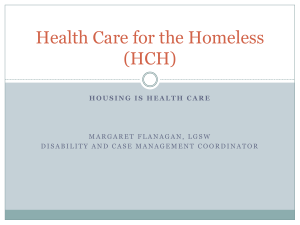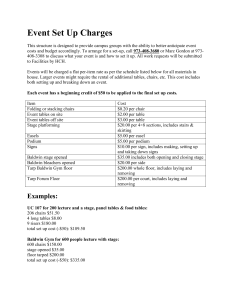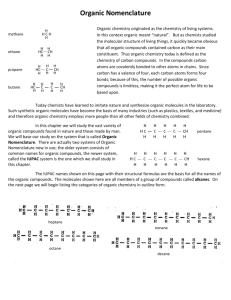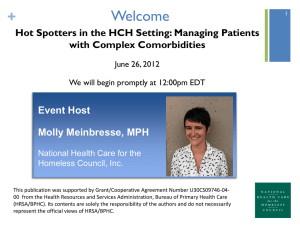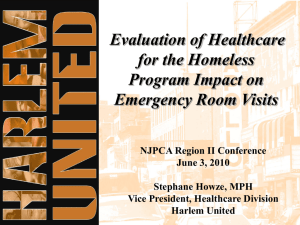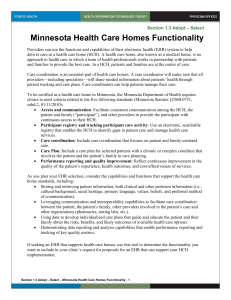BACHELOR OF SCIENCE IN COMMUNITY HEALTH COURSE
advertisement
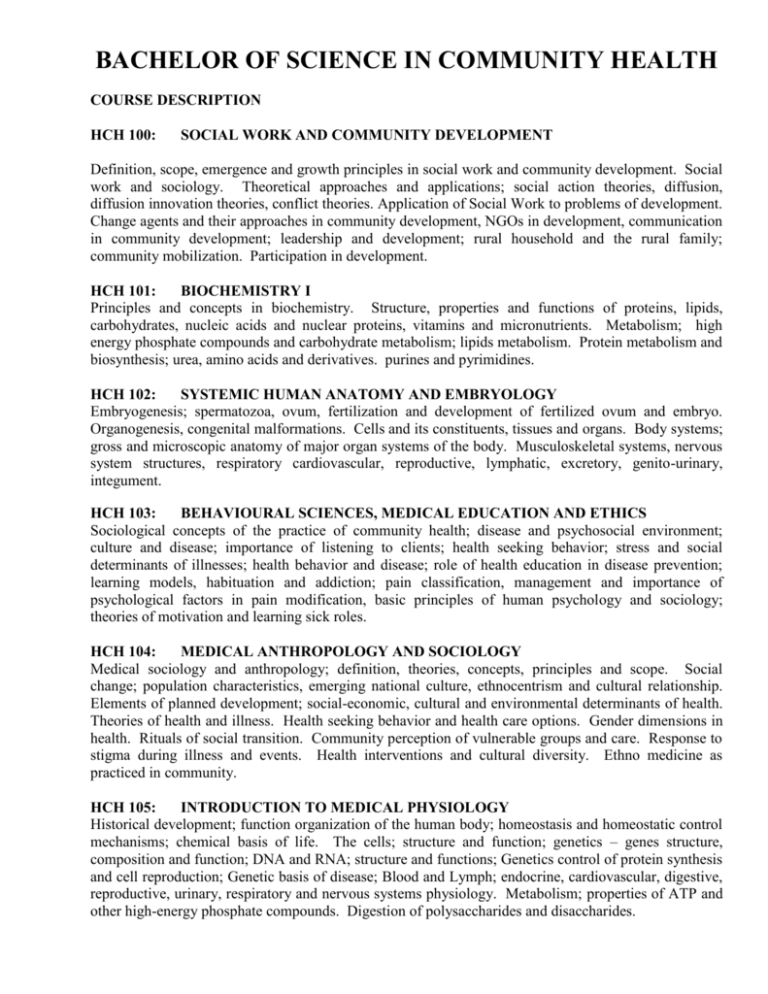
BACHELOR OF SCIENCE IN COMMUNITY HEALTH COURSE DESCRIPTION HCH 100: SOCIAL WORK AND COMMUNITY DEVELOPMENT Definition, scope, emergence and growth principles in social work and community development. Social work and sociology. Theoretical approaches and applications; social action theories, diffusion, diffusion innovation theories, conflict theories. Application of Social Work to problems of development. Change agents and their approaches in community development, NGOs in development, communication in community development; leadership and development; rural household and the rural family; community mobilization. Participation in development. HCH 101: BIOCHEMISTRY I Principles and concepts in biochemistry. Structure, properties and functions of proteins, lipids, carbohydrates, nucleic acids and nuclear proteins, vitamins and micronutrients. Metabolism; high energy phosphate compounds and carbohydrate metabolism; lipids metabolism. Protein metabolism and biosynthesis; urea, amino acids and derivatives. purines and pyrimidines. HCH 102: SYSTEMIC HUMAN ANATOMY AND EMBRYOLOGY Embryogenesis; spermatozoa, ovum, fertilization and development of fertilized ovum and embryo. Organogenesis, congenital malformations. Cells and its constituents, tissues and organs. Body systems; gross and microscopic anatomy of major organ systems of the body. Musculoskeletal systems, nervous system structures, respiratory cardiovascular, reproductive, lymphatic, excretory, genito-urinary, integument. HCH 103: BEHAVIOURAL SCIENCES, MEDICAL EDUCATION AND ETHICS Sociological concepts of the practice of community health; disease and psychosocial environment; culture and disease; importance of listening to clients; health seeking behavior; stress and social determinants of illnesses; health behavior and disease; role of health education in disease prevention; learning models, habituation and addiction; pain classification, management and importance of psychological factors in pain modification, basic principles of human psychology and sociology; theories of motivation and learning sick roles. HCH 104: MEDICAL ANTHROPOLOGY AND SOCIOLOGY Medical sociology and anthropology; definition, theories, concepts, principles and scope. Social change; population characteristics, emerging national culture, ethnocentrism and cultural relationship. Elements of planned development; social-economic, cultural and environmental determinants of health. Theories of health and illness. Health seeking behavior and health care options. Gender dimensions in health. Rituals of social transition. Community perception of vulnerable groups and care. Response to stigma during illness and events. Health interventions and cultural diversity. Ethno medicine as practiced in community. HCH 105: INTRODUCTION TO MEDICAL PHYSIOLOGY Historical development; function organization of the human body; homeostasis and homeostatic control mechanisms; chemical basis of life. The cells; structure and function; genetics – genes structure, composition and function; DNA and RNA; structure and functions; Genetics control of protein synthesis and cell reproduction; Genetic basis of disease; Blood and Lymph; endocrine, cardiovascular, digestive, reproductive, urinary, respiratory and nervous systems physiology. Metabolism; properties of ATP and other high-energy phosphate compounds. Digestion of polysaccharides and disaccharides. HCH 106: BIOSTATICS I Distributions of one variable, Normal distribution, Graphical tools for exploring relationships between variables, Densities and the normal distribution, Scatter plots, correlation, Descriptive Statistics and Frequencies, Scatter plots and Correlation, Probability, Sampling and Probability Distributions, Sampling distributions, Regression, Correlation, Inference, Linear regression & Multiple Linear Regression, Multiple Linear Regression, Analysis of Variance, Analysis of variance proportional hazards models YEAR 2 HCH 200: BIOCHEMISTRY II Metabolism of hemoglobin. Hormones, insulin glucagon, ADH, aldosterone, PTH, cortisol, HSG, thyroid hormones, reproductive hormones. Enzymes, classification, mechanism of action, factors affecting rate of action; vitamins, classification, functions, PCR; specimen collection, extraction, purification, concentration, amplification, determination. Tests, monosaccharides; turbid metric method for proteins. HCH 201: FUNDAMENTALS OF DEMOGRAPHY Demography: definition; rates ratios, proportions, importance and uses. Sources: census, registration, surveys. Population: definition, census growth, factors, effects. Composition: sex age, age dependency ratio, Age: measurement, structure. Population pyramids. Demographic transition theory. Fertility: description, analysis and measurement. Rates: crude birth, general fertility, age specific fertility, total fertility and specific fertility. Measures and Determinants of Mortality. Migration: description and analysis. Population Change and its Implications on Health at Community Level .Population Policies and their Implementation HCH 202: FUNDAMENTALS OF ENVIRONMENTAL HEALTH Environmental health concepts. Population and environmental health relationship. Hazards: classification and sources (air, soil, water, food based). Biological, Chemical, Physical, Radiological hazards and their health impacts. Environmental Health concerns: food safety and hygiene, occupational health and safety, community health, environmental pollution and built environment. Environmental health management strategies: Environmental Impact Assessment, Environmental Audit, Risk assessment HCH 203: INTRODUCTION TO MICROBIOLOGY Introduction to microbiology, microbial anatomy, microbial biochemistry, microbial growth, classification and identification of microorganisms, prokaryotes (bacteria), eukaryotes, viruses, disease and microorganisms, relationship between population health and micro-organisms, pathogenicity introduction to immunology, medical microbiology, environmental microbiology, microbiological applications. Sterilization and disinfection. The microscope: Benefits of Microbes to humans. Precautions in use of microbes.PPH 109 Anatomy and Physiology for Population Health HCH 204: INTRODUCTION TO MEDICAL PARASITOLOGY AND ENTOMOLOGY Introduction to human parasitology, classification of human parasites, protozoan and metazoan parasites. Medical protozoology including enteric and blood borne protozoan parasites. Plasmodium leshmania, trypanosome and entamoeba. Medical helminthology; cestodes, nematodes and trematodes. Medical entomology; Common vectors of disease and their lifecycles and control HCH 205: NUTRITION, HEALTH AND FOOD SECURITY Introduction to food and nutrition; components of an adequate diet. Dietary Reference Intake (DRI), toxicity and deficiency of macro and micronutrients; biological determinants of nutrient needs. Nutritional Disorders; causes of nutritional deficiencies and disorders, signs and symptoms and nutrition interventions for nutrition deficiency and disorders. Protein Energy Under-nutrition, vitamin A deficiency, iron deficiency, iodine deficiency. Nutrition and health; Interaction between nutrition and infection; Diet and health; Nutrition in (PEU); HIV/AIDS; Diabetes.Nutrition in the life cycle; infancy, childhood, adolescence, adulthood, pregnancy and lactation, old age. Nutrition Status Assessment; Methods, anthropometric, biochemical, clinical and dietary methods. Food Security. HCH 206: GENERAL SYSTEMIC PATHOLOGY Definition of pathology. Disturbances in metabolism of the proteins, lipids, carbohydrates and minerals and development of different degenerative changes. Causes and morphological types of necrosis. Disturbances of circulation and disorders of body fluid (edema, dehydration). General characteristic of the etiology and mechanism of development of the inflammation, morphological types of inflammation. Definition of neoplasia. Origin of tumors. Benign and malignant neoplasms. The tumor staging and tumour grading. Host reaction to tumours. Classification of neoplasms. Variety of tumours of epithelial and mesenchyinal origin. Tumours of the central nervous system. Lymphomas, teratomas. The aetiology pathogenesis, morphology, complications and results of various diseases of cardiovascular; respiratory; digestive; genitor urinary; central nervous; endocrine and locomotor systems. HCH 207: PRINCIPLES OF IMMUNOLOGY Introduction to immunology; historical perspectives, concepts of immunity and resistance to infection. Types of immunity; innate immunity, self and non self discrimination, acquired immunity, humoral and cell mediated. Cell, organs and tissue immune system. Origin structure and functions, lymphocyte activation and traffic. Immunoglobin structure, functions and biological roles. Theories of generation diversity. Antigens: types of classes; adjuvants and adjuvacticity. Simple anti-body reactions in vitro. Allergic reactions to immunity. Immunilogical control of infectious diseases, immunological disorders, immunnosuppression. Reproductive immunology. Immunotheraphy. Vaccination and immunization. Types of vaccines; vaccine production, monitoring of vaccine efficacy and adverse effects, new generation vaccines HCH 208: HEALTH EDUCATION AND PROMOTION Health promotion theories and models. Concepts and strategies, methods of instruction in health education. Current practices related to curriculum design in health professions. Impact of computer technology on communication and instructional techniques for health professions education; exploration of distance education, on-line learning, and low and high fidelity simulation. Assessment of competence in health care professional training. Skill and performance; assessment, strategies for developing assessment instruments; interpretation and communication of evaluation results HCH 209: MEDICAL VIROLOGY Introduction to pathogenic viruses, virus structure and architecture. Classification and nomenclature. Interaction of viruses with cells, subcellular organelles and targets macromobules; viral replication process, attachment, viropexis, transport, uncoating, transcription synthesis of viral genome, assembly, packaging and release. Propagation of viruses and serological tests for virus identification. Viral diseases; causes and management. HCH 210: TOXICOLOGY Definition and classification of poisonous substances encountered in the environments. Common sources of poisoning. Toxicokinetics, absorption, distribution, metabolism and elimination of xenobiotics, mechanisms of action recognition and alleviation of poisoning. Mutagenic and carcinogenic effects of toxicants. Micro-organisms as pollutants indicators. Pollution pathways in aquatic and terrestrial microbial communities. Effects of chemicals in water, air, soil and transformation of pollutants. Problems solving approach to predict how chemicals behave in the environment. HCH 211: BASICS OF PHARMACOLOGY AND PHARMACOGNOSY Introduction to Pharmacology, definition, pharmacokinetics drug administration, absorption, distribution, biotransformation, excretion. Pharmacodynamics, mechanism of drug action. Specific and non-specific structure-activity relationship; receptor mediated drug effects, dose effect and concentration effect relationships, rational and irrational drug combinations, pharmacogenatics drugs forms and routes of administration. Essential drugs; drugs nomenclature; drugs development and drug trials, adverse drug reactions, introduction to pharmacognosy, medicinal and toxic plant substances, ethnopharmacology drug prescription, general management of poisoning. HCH 212: FIELD ATTACHMENT I This field attachment will focus on activities in the municipal council with the aims of exposing the learners to the broad spectrum of all population health problems faced by communities: such as, Water safety, Public Health law enforcement; Immunization. YEAR 3 HCH 300: EPIDEMIOLOGY I Introduction, scope and objectives of epidemiology. Disease transmission and interaction with environment. Measures of Health status. Disease surveillance and outbreak investigation. Validity and reliability of diagnostic and screening tests. Natural history and prognosis of disease. Ethical and professional issues in epidemiology. Epidemiological studies. Principles of disease prevention and screening. The basic epidemiological designs (observational, case-control, cohort, time series, and randomized control studies). Evaluation of clinical, epidemiological, and health administration evidence. Behavioural, social and emotional aspects of disease patterns. HCH 301: BIOSTATISTICS II Basic statistical techniques for analyzing data from epidemiology, environmental health and biomedical and other community health-related research. Descriptive statistics, elements of probability, introduction to estimation and hypothesis testing, nonparametric methods, techniques for categorical data, regression analysis, analysis of variance, and elements of study design. Determination of rate-of-occurrence (e.g., incidence rate), and time-to-event (survival duration). Applications in epidemiology, clinical trials, and other public health research. measures of association, 2x2 tables, stratification, matched pairs, logistic regression, model building, analysis of rates, and survival data analysis using HCH 302: RESEARCH METHODS Definition of concepts: Scientific verses other methods of enquiry: Purpose and importance of research, types of research. Sources of research ideas. Proposal writing: format, statement of the research problems, research questions and hypothesis. Literature review, research budget and funding. Research designs: experimental, quasi-experimental and non-experimental designs. Sampling designs: nonprobability and probability sampling designs. Sample size selection. Scales of measurements in research. Data collection methods: laboratory research, observational, questionnaires and interviews. Data coding, analysis and interpretation. Communication in research. HCH 303: FUNDAMENTALS OF HEALTH INFORMATION MANAGEMENT An introduction into the principles and procedures used in medical record organization, maintenance and retention, numbering and filing systems and procedures, forms, control and design, and microfilming. Data analysis and system design. Integration of the use of general computerized office application with specific Health Information Management applications. The functions and duties of the medical record professional and relationships of the medical record to the health care delivery system. Practical knowledge of these applications. HCH 304: HEALTH SERVICES MANAGEMENT Management: definition, concepts, principles and theories. Organization: theory; behaviour and Structure,. Management: function; roles and skills, time management; Total Quality Management (TQM). Strategic management – theories, practices and concepts. Financial Management: definitions, concepts, principles. Budgeting: definition, perquisites, functions, types. The Financial Audit Process. Health care financing reforms. Personnel management; definition, concepts and function; policies; problems and processes. Motivation and morale. Performance appraisal. Resistance to change. Stress management. Personnel record and information systems HCH 305: DISASTER MANAGEMENT Disasters: concepts; theories; & Classification. Comprehensive emergencies management. Risk, hazards, and Disaster VS health. Epidemiologic surveillance & disease control in disasters. Risk accumulation model. Mitigation & preparedness. Co-ordination of disaster responses. Health needs assessment. National Health Disaster Programme planning. Mass fatalities Management. Medico-legal work in disasters. Management of humanitarian assistance: humanitarian reliefs and SUMA. Disasters & critical facilities. humanitarian law and ethics. HCH 306: HEALTH ECONOMICS AND HEALTHCARE FINANCING Economics: principles, concepts and theories. Economics and welfare. Economic instruments: governance, environmental taxation, property rights and tradable permit. Comparative environmental economic assessment: Cost analysis, valuation method and estimation of non-market value. Public goods and externalities. Tragedy of the commons. Elements of Bioeconomics and macroeconomics. HCH 307: COMMUNITY DIAGNOSIS Introduction; establishing a Community Assessment Team. Analyzing the available literature. Collecting Community Data. Combining reviewed literature with Community Data. Choosing Health Priorities. Developing the Community Health Action Plan. Measuring population health and Policy Changes. Creating the Community Assessment Document. Dissemination of the findings. Students will be required to do the diagnosis neighbouring rural community HCH 308: COMMUNICABLE DISEASE CONTROL (CDC) Introduction: concepts, definitions and classifications. Disease causing organisms. Common tropical diseases: distribution; etiology; risk factors; signs and symptoms; diagnosis; treatment; prevention and control. Emerging and re-emerging diseases HCH 309: NON-COMMUNICABLE DISEASE CONTROL Non infectious diseases; causes, control and prevention of Cardio-vascular diseases; Cancers; Diabetes mellitus: Dental Caries; Tobacco; Substance abuse and related disorders; mental disorders. Stress related diseases and disorders. Role of exercise in prevention of Non-communicable diseases. Injuries and RTA injuries. HCH 310: SOLID WASTE MANAGEMENT Principles, concepts and scope of solid waste management (SWM). Waste characterisation. Design and organization of SWM. Solid waste: Storage; collection; transport; transfer station; salvage schemes and material recovery facilities; and disposal. Special / hazardous wastes. Street cleansing. Laws governing solid wastes. Gender and SWM. Reduce Reuse Recycle (RRR) principles. Modern thinking in SWM. Case studies. Planning, operation, closure, after-care and environmental impact assessment of the land fill. HCH 311: LIQUID WASTE MANAGEMENT Wastewater: Concepts, sources, classification and concerns. Composition and standards of wastewater. Physical, Biological and Chemical parameters in wastewater quality assessment. Wastewater treatment methods: primary, secondary and tertiary. Sewer and sewerage design. Design of wastewater management facility (waste stabilization pond, reed beds, activated sludge and percolating filters). Disposal systems. Other technologies: waste avoidance, minimization, recycling and reuse) HCH 312: BEHAVIOUR CHANGE COMMUNICATION Definition of concepts and principles of Effective BCC. Analytical and planning frameworks, Community mobilization, Social marketing. Indicators in BCC. Strategies: Understanding the Situation. Focusing & Designing. Creating the change. Implementing & Monitoring. Evaluating & Re-planning. Advocacy/policy change. Interpersonal communication HCH 313: FIELD ATTACHMENT II This is to expose students to actual Population health issues and problems. The student will be attached to a project or an office for two months. Two months of attachment are expected to give the students adequate exposure to the required experience and skills in Population health management. The students will be attached to on-going population health projects, communicable disease control centres, hospitals, community based organizations, government bodies, non-governmental organizations with health programs \ YEAR 4 HCH 400: Epidemiology II Application of epidemiology in disease control and prevention: clinical and community trials; risk estimation and prevention. Epidemiology of selected infectious and chronic disease of public health importance. Epidemiological study designs and applications. Association and causation. Biological inferences. Epidemiology in evaluation of health interventions and health policy. Ethical and professional issues in epidemiology. Emerging and re-emerging diseases. Pharco-epidemiology. HCH 401: MATERNAL AND CHILD HEALTH PROGRAMS Overview of maternal and child health programs. Calculating, interpreting and utilizing coverage indicators. MCH programs. FANC. Delivery. Postpartum Care. Measures of morbidity and mortality for mother and child. Newborn care. Safe motherhood initiative. IMCI – health care worker and community IMCI, ORT, Immunization; Nutritional assessment, breastfeeding, weaning foods. PMTCT. Cold chair for immunization. Delays in maternal care. Maternal deaths and audit. HCH 402: HIV/AIDS AND TB PREVENTION AND CONTROL PROGRAM Introduction to HIV/AIDS and tuberculosis programs: Behavior Change Communication (BCC) Programs: Role of BCC in HIV/AIDS; Program components to monitor; Indicators; M&E methods and tools (participatory monitoring; qualitative and quantitative monitoring); Data use and influence on data collection and analysis; (B) Voluntary Counseling and Testing Services (VCT): Definition of VCT; Monitoring VCT programs (goals and objectives. (C) Programs for the Prevention of Mother-to-Child Transmission of HIV/AIDS (PMTCT): Goals and Objectives; What to monitor; Developing monitoring questions; Monitoring indicators, methods and tools (PMTCT monthly reporting form, etc.); (D) Clinical care and treatment programs: definition of clinical care; essential elements of anti-retroviral therapy (ART (E) Orphans and Vulnerable Children (OVC) Programs: Definition of OVC; Monitoring OVC programs; Developing, goals, objectives, and M&E questions; indicators; Monitoring methods and tools; Evaluating OVC programs. (F) Tuberculosis Programs: Technical and programmatic approaches: Kenya National TB and Leprosy Control Strategy 2006-10, the Global Plan to STOP TB: Actions for Life. 2006 – 2015, DOTS Expansion, DOTS Plus for MDR-TB/XDR-TB., TB/HIV integration, TB Diagnostics, TB Drugs, TB Vaccines, advocacy, communication and social mobilization. HCH 403: NUTRITIONAL PROGRAMS Introduction to nutrition monitoring: nutritional status, problems of under- and over-nutrition, nutrition transition, causal frameworks, national nutrition monitoring systems. Dietary assessment tools: 24-hour recall, food frequency, food record, household level recall for developing countries. Interpretation of dietary data: reference standards, dietary guidelines, pyramid servings; usual intake, intra/interindividual variability. Measures of diet quality: diet diversity and diet quality indices in developing countries. Food consumption knowledge and behaviour: child care feeding practices, indicators, child feeding index. Anthropometry: growth and development, assessment of anthropometric status, height and weight data, reference standards, conversion to z-scores, indicators for stunting, wasting, and low weight, BMI-for-age curves, body composition assessment tools. Food security and economic indicators: definitions and frameworks, FAO food balance sheet, livelihood approach, food security module, developing country applications, food expenditures, assessment of food poverty. Biochemical indicators and clinical signs: iron deficiency anaemia, iodine status, vitamin a status, protein-energy malnutrition. HCH 404: MALARIA PREVENTION AND CONTROL PROGRAM Roll Back Malaria (RBM) recommended malaria control interventions: vector control (insecticide-treated nets and indoor residual spraying), prevention of malaria in pregnancy, case management. Program monitoring: sources of data, monitoring service utilization, monitoring program organization, health information systems. RBM and President Malaria Initiative (PMI) indicators: PMI monitoring indicators, guidelines for core population coverage indicators, management information system (MIS) indicators. Site visits to health facilities to review and assess case management data. Fieldtrip to indoor residual spraying program: review and assessment of coverage data. Impact evaluation assessment: design strategies, bias, validity, generalizability. Non-experimental design studies: descriptive study designs, multivariate regression analysis, limitations and practical considerations. Use of surveys in malaria control program evaluation: multi-stage cluster design. Measuring health practices, morbidity and mortality: examples from DHS, MICS, and MIS. Malaria operations research: Kenyan and other African examples. Modeling malaria impact: applying the child survival IMPACT model. . HCH 405: COMMUNITY DIAGNOSIS AND COMMUNITY DIRECTED INTERVENTION Historical overview, description of the process, the partners, facilitators of various approaches to community health care service delivery approaches. Evolution of CDI, community composition, structure, organization, social norms, socio-economic and political characteristics of the community. CDI strategy, role of community training institutes, partners empowering community. Attitudes by health workers. Training of community volunteers. Community leaders. Implementation of interventions. Planning and Evaluation of community diagnosis. Dissemination. HCH 406: REPRODUCTIVE HEALTH AND FAMILY PLANNING PROGRAMS Reproductive Health; sexually transmitted diseases, causes, signs and symptoms, prevention and management. Gender disparities and presentations of STIs. Diseases of R.H, fibroids, breast cancer, infertility, HPV, prostate cancer, cervical cancer. Prevention and control of the same. Family Planning; family planning methods, family planning education, supplies of contraceptives, pregnancy testing, reproductive health advocacy. Abortion, emergency contraception, determinants of poor reproductive health, gender issues, research. HCH 407: MENTAL HEALTH, ADOLESCENT HEALTH AND DRUG AND SUBSTANCE ABUSE PROGRAM Prevalence, risk factors, treatment, prevention of major mental disorders that begin during childhood and adolescence, including mood disorder, conduct disorder, post-traumatic stress disorder, learning disorders, substance abuse, youth suicide. Psychiatric morbidity; mood disorders, anxiety, schizophrenia, classification. Basic concepts; signs and symptoms, characteristics and effects of commonly used drugs and substances, anatomy and neurophysiology in drug use. Medical complications and drug and over dose management. Treatment and rehabilitation of drug abuse and addiction. Government, inter-sectoral and community approaches to inform, minimize and treat the harm caused by the use of alcohol and other drugs. National and global policies. HCH 408: ETHICS AND MEDICAL-LEGAL ISSUES Law, ethics and human rights pertaining to handling, management, prevention and control of serious diseases; health rights for children, restricted persons and in-matter; bio-ethics and research, international trade in health care products. Intellectual Property Rights, policy guidelines and enforcement. HCH 409: OCCUPATIONAL HEALTH AND SAFETY Definition of concepts, types of safety and health hazards. Risk assessment and hazard analysis. Risk communication Reasons for occupational safety and health. Common workplace hazard groups. Occupational health and safety legislation. Employment and labour laws. Workforce policy and planning HCH 410: GENDER AND HEALTH Knowledge on gender and related concepts, gender in society and culture, gender analysis, sociology, anthropology and psychology in relation to gender human rights as well as sexual and reproductive health rights. Medical-legal issues related to gender policy framework regarding gender issues and G.B.V. Life skills for self-defense. Sensitivity and the use of gender lens to assess possible GBV situations. Gender mainstreaming advocacy skills. Managing survivors of G.B.V. Gender/responsiveness. HCH 411: FUNDAMENTALS OF MONITORING AND EVALUATION Introduction to monitoring and evaluation (M&E): definition, rationale, historical development, types of evaluation, relationship to program stages and cycles, social/political context of evaluation. Developing effective evaluation strategies: diagnostics and project design, methods for conducting needs assessments, scope of evaluation efforts for new and existing programs. Frameworks, indicators, and data sources: conceptual frameworks, logic models, logical frameworks, indicators, sources of data and their strengths and limitations. Program monitoring: definition and purposes, key monitoring issues, standard protocols used in international PHN sector, analysis of monitoring data. Questionnaire development. Communication and utilization of M&E findings: factors affecting utilization of M&E results, designing utilization-focused evaluations, strategies and tools for promoting information use. Developing a comprehensive monitoring and evaluation plan for a public health program. HCH 412: HEALTH PROJECT MANAGEMENT Project management: principles, concepts and progress; Types of projects, Project life cycle. Strategic contexts of the project. Functions of management: planning, implementation and evaluation. Project management information system. Leadership: teamwork and team development. Project proposal writing, creativity, innovation. Control. Project monitoring and evaluation, sustainability, termination. Health project planning: the planning cycle, tools for project planning (Gantt char, logical framework, budget matrix), project goal and objectives, project strategies and activities. Health project evaluation. The evaluation process, participatory project evaluation, external evaluation, internal evaluation and MS project. HCH 413: RESEARCH PROJECT In this project the student will be required to carry out research after selecting a topic with the guidance of the supervisor. The research will involve field, laboratory or library components. The student will then have to present the findings in form of an examinable project report
